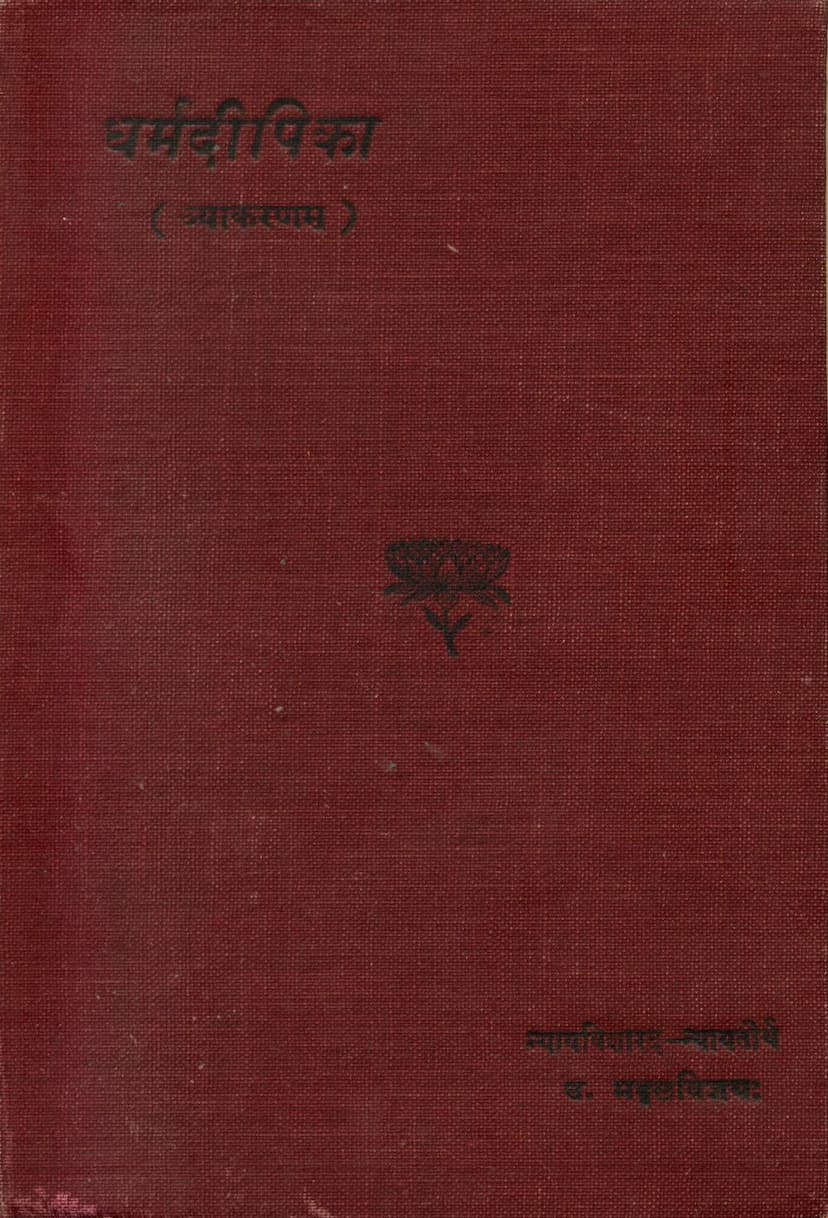Dharmdipika Vyakaranam
Added to library: September 1, 2025

Summary
This document is a comprehensive summary of the Jain text "Dharmdipika Vyakaranam" (धर्मदीपिका व्याकरणम्), authored by Upadhyaya Shrimangalvijay. It was published by Yashovijay Jain Granthmala in Bhavnagar. The text is a grammar treatise written in Sanskrit, intended to simplify the learning of Sanskrit grammar for Jain followers, particularly in relation to the influential "Siddha-Hem" grammar of Acharya Hemachandra.
Here's a breakdown of the content as presented in the provided pages:
Key Information and Dedication:
- Title: Dharmdipika Vyakaranam (धर्मदीपिका व्याकरणम्)
- Author: Upadhyaya Shrimangalvijay (उपाध्याय श्रीमङ्गलविजयः), who is described as a scholar in logic and possessing the titles Nyayavisharad and Nyaytirth.
- Publisher: Yashovijay Jain Granthmala, Bhavnagar.
- Printing: Printed at 'Luhana Mitra Steam Print. Press' in Vatpadra.
- Publication Details: Published in Dharm Samvat (ध.सं.) 4 and Veer Samvat (वी.सं.) 2451, corresponding to Vikram Samvat (वि.सं.) 1981. The first edition was published with a circulation of 500 copies.
- Dedication: The initial pages contain a "Guru Dev-Pushpanjali" (गुरुदेव-पुष्पाञ्जलिः), a floral offering of verses dedicated to their revered guru, Sūrendra Sri Vijaydharmasūri, praising his intellectual contributions, advocacy for non-violence, and the establishment of Sanskrit learning.
Introduction and Purpose:
- The "Prastavana" (प्रस्तावना - Introduction) highlights the importance of grammar (व्याकरण) for language refinement and proper conduct.
- It emphasizes the sweetness, engagement, and soul-stirring qualities of Sanskrit, considering it the divine language (गीर्वाणवाणी).
- It acknowledges the existence of numerous Sanskrit grammars, both Jain and non-Jain. However, it notes that Jain grammars have fallen into obscurity, leading to the widespread study of grammars like Panini's.
- The author introduces this work, "Dharmdeepika," as a simplified grammar, inspired by Acharya Hemachandra's "Siddha-Hem," which is considered vast and requires significant time and intellect to master. The author aims to make Sanskrit composition accessible to students with minimal effort through this grammar.
Content and Structure:
The book is divided into two main parts: "Purvardha" (पूर्वार्ध - First Part) and "Uttarardha" (उत्तरार्ध - Second Part).
Purvardha (First Part):
The Purvardha covers foundational aspects of grammar, including:
- Malacharanam (मालाचरणम्): Invocation and salutations.
- Sanjnaprakaranam (संज्ञाप्रकरणम्): Introduction to grammatical terms and categories, such as vowels (स्वर), consonants (व्यञ्जन), udātta, anudātta, svarita, classes of consonants (वर्ग), etc. This section delves into phonetics and the classification of Sanskrit sounds according to traditional Indian grammar.
- Sandhiprakaranam (सन्धिप्रकरणम्): Rules for the joining of sounds (sandhi), including:
- Svara Sandhi (स्वर सन्धि - Vowel Sandhi)
- Vyanjana Sandhi (व्यञ्जन सन्धि - Consonant Sandhi)
- Visarga Sandhi (विसर्ग सन्धि - Visarga Sandhi)
- Shadlingaprakaranam (षड्लिङ्गप्रकरणम्): Six grammatical genders.
- Yushmadasmatprakriya (युष्मदस्मत्प्रक्रिया): Rules for pronouns "yushmad" (you) and "asmad" (I).
- Avyayaprakaranam (अव्ययप्रकरणम्): Indeclinables or adverbs.
- Stree Pratyayaprakaranam (स्त्रीप्रत्ययप्रकरणम्): Feminine affixes.
- Karakaprakaranam (कारकप्रकरणम्): Grammatical cases and their functions.
- Samasaprakaranam (समासप्रकरणम्): Compound words.
- Taddhitaprakaranam (तद्धितप्रकरणम्): Suffixes added to nouns.
- Purvardha-Sutranukramanika (पूर्वार्ध-सूत्रानुक्रमणिका): An index of the sutras (aphorisms) in the first part.
The Purvardha is estimated to span approximately 240 pages.
Uttarardha (Second Part):
The Uttarardha focuses on verbal aspects and more advanced grammatical concepts, including:
- Dash Gana (दश गण): Ten classes of verbs, containing approximately 1700 roots (धातु).
- Dash Prakriya (दश प्रक्रिया): Ten grammatical processes or formations.
- Kṛtyaprakriya (कृत् प्रक्रिया): Formation of primary derivatives (krits).
- Pūrvakṛdantāni (पूर्वकृदन्तानि): Primary derivatives forming the first part of a compound.
- Uṇādayaḥ (उणादयः): Special primary derivatives.
- Uttarakaṛdantāni (उत्तरकृदन्तानि): Primary derivatives forming the second part of a compound.
- Other useful topics: Including the rules of the Dhatupatha (धातुपाठ), logic (न्याय), and definitions of substance (द्रव्य), quality (गुण), genus (जाति), etc.
- Uttarardha-Sutranukramanika (उत्तरार्ध-सूत्रानुक्रमणिका): An index of the sutras in the second part.
- Parishishte (परिशिष्टे - Appendix): Containing definitions of anu-bandha (अनुबन्ध), explanations of verb roots (धातुपाठ सूची), and collection of verses (संग्रहश्लोकाः).
- Shuddhipatraka (शुद्धिपत्रकम्): A corrigenda or errata list.
The Uttarardha is estimated to be around 500 pages long.
Key Features and Author's Approach:
- Simplicity and Clarity: The author has made a concerted effort to ensure the language is simple and accessible from beginning to end, making the study of Sanskrit enjoyable and beneficial.
- Comprehensive Coverage: The book aims to cover the essential aspects of Sanskrit grammar in a systematic and comprehensive manner.
- Jain Context: While a grammar book, its publication by a Jain press and the dedication to Jain Acharyas indicate its intended audience and connection to Jain educational traditions.
- Gratitude: The author expresses heartfelt gratitude to various individuals who assisted in the creation and publication of the work, including:
- Shri Nyayavijay (श्रीमान् न्यायविजयेन), a colleague who provided grammatical assistance.
- Shri Jayantavijay (जयन्तविजयादि), Muniraj Shri Jayantavijaya.
- Pandit Lalchand (पण्डित लालचन्द), son of Bhagwandas Shreshthi, for diligent research and beautification of the grammar.
- The proximity and support of Jainacharya Shri Vijyendrasuri (जैनाचार्यश्री विजयेन्द्रसूरि) in bringing the book to light.
Errata (Shuddhipatraka):
The final pages presented include an "errata" list, indicating corrections to errors in the printed text, a common practice in scholarly publications.
In essence, "Dharmdipika Vvyakaranam" is a valuable resource for learning Sanskrit grammar, particularly for the Jain community, offering a structured and simplified approach to a complex subject.